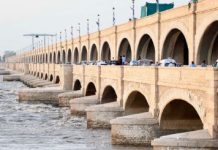Imran Qazi
Nations around the world struggle to achieve sustained economic growth and development. Pakistan, despite its rich natural resources and strategic location have failed to achieve its goals. Country like Malaysia, Singapore, Taiwan, South Korea and Indonesia have left behind Pakistan in all socio-economic indicator. Today, Pakistanis are witnessing the worst inflation in their history and problems like terrorism, water scarcity and a burgeoning population are hanging like the sword of Damocles over their heads.The masses have failed to challenge the feudal culture, extractive institutions and rampant corruption. Some of the key problems that fails Paksitan are enumerated as below.
Pakistan’s political system has been characterized by instability and uncertainty for several decades. The country has experienced multiple military coups, political assassinations, and civil unrest, which have created an unpredictable business environment and discouraged foreign investment. The lack of stable and inclusive political institutions has contributed to a culture of corruption and nepotism, which has limited economic growth and development.
The concentration of power in the hands of a small political and military elite has also contributed to the failure of political institutions in Pakistan. The ruling class has consistently used their power to extract resources and benefits from the general population, which has limited opportunities for economic growth and development. The lack of accountability and transparency in the political system has allowed this elite to maintain their power and control over the country’s resources.
Pakistan’s economic institutions have also been a major factor in the country’s underdevelopment. The country has a history of protectionist policies and state intervention in the economy, which have limited competition and innovation. The government has historically favored large corporations and state-owned enterprises over small and medium-sized businesses, which has led to a concentration of economic power in the hands of a few elites.
The lack of infrastructure and human capital investment is another major factor in Pakistan’s economic failure. The country’s infrastructure, including transportation, energy, and communication networks, is inadequate and has limited the country’s productivity and competitiveness. The education system in Pakistan is also in dire need of reform, as a large proportion of the population remains illiterate and lacks basic skills for participation in the modern economy.
The failure of political and economic institutions in Pakistan has contributed significantly to the country’s underdevelopment. The concentration of power and resources in the hands of a small elite has limited opportunities for economic growth and development, while the lack of infrastructure and human capital investment has hindered productivity and competitiveness. Moving forward, Pakistan will need to prioritize reforms that promote inclusive political and economic institutions, encourage competition and innovation, and invest in human capital development. Only then can Pakistan hope to achieve sustained economic growth and development.
In their book, “Why Nations Fail: The Origins of Power, Prosperity, and Poverty,” economists Daron Acemoglu and James A. Robinson argue that the key determinant of a nation’s success or failure lies in its political and economic institutions. Institutions are the rules, norms, and practices that govern social and economic behavior within a society. According to Acemoglu and Robinson, there are two types of institutions: inclusive and extractive.
Inclusive institutions are those that provide a level playing field for all citizens, regardless of their background or social status. These institutions provide a broad range of economic and political opportunities, allow for the free flow of ideas and innovations, and encourage competition and innovation. Inclusive institutions encourage investment and entrepreneurship, which leads to economic growth and development.
Extractive institutions, on the other hand, are those that are designed to extract resources and power from the majority of the population and concentrate them in the hands of a small elite. These institutions restrict political participation, limit economic opportunities, and stifle innovation and creativity. Extractive institutions lead to poverty, political instability, and social conflict.
So, nations that have inclusive institutions tend to be successful and prosperous, while those that have extractive institutions tend to fail. Pakistan is largely dominated by extractive institutionsand the transition from extractive to inclusive institutions is not easy, and may requires a significant shift in power relations within Pakistan.
One of the key challenges in transitioning from extractive to inclusive institutions is overcoming the resistance of the existing elites who benefit from the extractive institutions. These elites often control the political and economic system and will resist any attempts to change it. Overcoming their resistance requires a social movement that is able to mobilize the population and demand change.
Another challenge in transitioning to inclusive institutions is developing the necessary infrastructure, such as education and healthcare, to support economic growth and development. This requires a significant investment in human capital, which can be difficult to achieve in societies that are dominated by extractive institutions.
In conclusion, Acemoglu and Robinson’s provides a compelling analysis of the role of political and economic institutions in determining a nation’s success or failure. It helps us to understand why Pakistan is sinking in the quagmire of poverty and debt. Pakistan could only achieve sustained economic growth if it transitioned its extractive institutions into inclusive institutions. This is possible with a bloodless revolution. All the stakeholders should sit together and find a path that leads to inclusive institutions. They need to compromise on certain things and sacrifice the status quo for the sake oftwo hundred and thirty-two million Pakistanis. By promoting inclusive institutions, Pakistan can create a level playing field for all citizens, encourage investment and entrepreneurship, and achieve long-term prosperity and stability.












